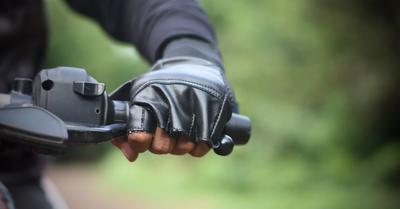Shelf life factors and warning signs
- Manufacturer date
- Weathering
- Chinstrap
- Dings and scratches
- Inner padding
- Glue and Resin
- Manufacturer re-calls
- Where to buy a new Helmet
Manufacturer date
If you feel like your helmet is getting on the older side of the scale, then it is recommended that you check the manufacturer's date.
It should be either on a sticker on the inside of the helmet or printed directly onto the inside.
Please note that most manufacturers state that if you are riding with a helmet that is older than five years, you are riding at your own risk.
It’s best to be safe, flip your lid and check the date.
Different helmets will have different places where the dates are printed or stuck, check the manufacturer's website to see where yours is located if you can't find it.
Weathering
Extreme exposure to sunlight can cause your helmet to age, the outer shell can become hard and start to splinter.
It needs to be remembered that, that outer shell is your first line of defense between your head and the road.
Helmets are mostly made of kevlar, fiberglass, carbon fiber, and polycarbonate, they will age over time due to UV exposure.
Look out for yellowing or any discoloration.
This is a sign that your helmet is getting old. It is also good to remember that your helmet needs to be stored in a dry room-temperature environment. Away from direct sunlight.
Chinstrap
Let’s not even play around, the chin strap is what is holding the helmet to your head.
If it has started to fray or the clips are coming loose, it may be time for a new helmet. You could also send it to the manufacturer and request for a new strap to be sewn in.
This will come at an extra fee, depending on your warranty. Always ensure that the strap is clipped properly and that it does not allow for the helmet to wiggle around on your head.
The fit needs to be snug, Over time the strap may loosen due to age.
Dings and Scratches
You should constantly check your helmet for deep abrasions, paint scratches can be fine (but please make sure it's just paint scratches) on the surface level but if they go any deeper and there is a clear tear through the outer shell, it is time for a new helmet.
If you have been in any form of an accident where your helmet has taken a fall or hit the ground, then it is time for a new one, regardless of how old the helmet is.
Your helmet should never be in a state of disrepair, check your helmet before every ride, the same way a pilot checks all the instruments of his plane before every flight.
It is also good to remember that although your helmet may look okay from the outside if it has taken a fall and hit the tar or rocks, there is a good chance for it to develop micro-cracks.
Inner Padding
The inner padding is just as important as the outer shell, if the inner padding has started to fray or crumble, then it is time for a new helmet.
Sometimes, on the rare ocean, you can send the helmet back to the manufacturer and they will reline the inner padding.
Remember, the inner padding is what protects your head from the outer shell and will take most of the force of the impact as it travels through the outer shell and into the padding, therefore the padding is a vital part of the helmet and needs to be checked constantly.
Remember not to wear any headgear that may cause the padding to tear or break. Sweat and mister will cause the padding to deteriorate and the glue may come undone after time.
Some people opt for cheap foam inserts but we advise against this as they come apart after a few short months.
You are riding at your own risk if you choose to ride with faulty broken padding.
Glue and Resin
Over time, the glue and resin that hold the inner lining to the inside of the outer shell may come undone and start to break down due to age and environmental reasons.
Once this starts to happen, it is time to get a new helmet. As stated above, some opt for cheap foam inserts, but this is not a good idea.
Manufacturer recalls
Every now and then a manufacturer will recall some gear, including helmets due to defective parts. It is wise to keep your eyes peeled for any news from your manufacturer.
You will need to have your helmet replaced if the manufacturer has recalled it for any reason. It is wise to never ignore a recall as this could save your life.
Where to buy a new Helmet
Besides going in-store to find and fit the helmet you desire, there are some great online stores like Amazon, Cyclegear, and Revzilla respectfully, which have a great selection of helmets for sale. Remember to always buy new helmets. It is not recommended to buy second-hand.














